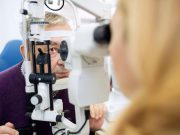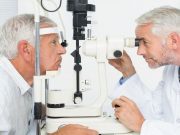Tag: Macular Degeneration
Two Disease Processes Contribute to Age-Related Macular Degeneration
Lesions from soft drusen/pigment epithelial detachments have lower mean quantitative autofluorescence, while those from subretinal drusenoid deposits have higher
Dietary Nitrate Intake Linked to Lower Risk for AMD Progression
Higher dietary nitrate intake linked to reduced risk for progression to late age-related macular degeneration
Bevacizumab, Aflibercept Compared for Neovascular AMD
At the end of one year, likelihood of being weaned off treatment was higher for eyes treated with aflibercept versus bevacizumab
Subretinal Drusenoid Deposits Linked to High-Risk Vascular Disease in AMD
Presence of HRVD can be identified in model including SDD, high-density lipoprotein with accuracy of 78.5 percent
Lipid-Lowering, Antidiabetic Drugs Tied to Prevalence of AMD
Use of lipid-lowering drugs, antidiabetic drugs associated with lower prevalence of any age-related macular degeneration
Age-Related Macular Degeneration Prevalence Remains High
1.49 million people aged 40 years and older are living with late-stage AMD in the United States
AAO: One in Nine Patients With Wet AMD Skip Follow-Up
Odds of being lost to follow-up greater among very old patients, Black and Hispanic patients, and Medicaid patients
Pathways to Advanced Age-Related Macular Degeneration Examined
Distinct serum and genetic risks, associated systemic diseases seen with soft drusen, subretinal drusenoid deposits
Cost of Ranibizumab Port Delivery System for Treating nAMD Examined
Model compares costs for ranibizumab port delivery system versus conventional intravitreal antivascular endothelial growth factor injections
Lutein/Zeaxanthin in AREDS2 May Slow Progression to Late AMD
No increased risk for lung cancer, reduced risk for progression to late AMD seen with lutein/zeaxanthin as replacement for beta-carotene














